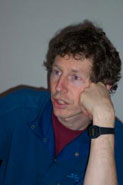|
|
| |
|
| |
Invited Speakers |
|
| |
 |
|
Frank van Harmelen
Vrije Universiteit Amsterdam
http://www.cs.vu.nl/~frankh/
[Download Presentation]
Where does it break? or: Why the Semantic Web is not just "research as usual"
Abstract
Work on the Semantic Web is all to often phrased as a technological
challenge: how to improve the precision of search engines, how to
personalise web-sites, how to integrate weakly-structured data-sources,
etc. This suggests that we will be able to realise the Semantic Web by
merely applying (and at most refining) the results that are already available from many branches of Computer Science. |
I will argue in this talk that instead of (just) a technological challenge,
the Semantic Web forces us to rethink the foundations of many subfields of
Computer Science. This is certainly true for my own field (Knowledge
Representation), where the challenge of the Semantic Web continues to break
many often silently held and shared assumptions underlying decades of
research. With some caution, I claim that this is also true for other
fields, such as Machine Learning, Natural Language Processing, Databases,
and others. For each of these fields, I will try to identify silently held
assumptions which are no longer true on the Semantic Web, prompting a
radical rethink of many past results from these fields.
Bio
Frank van Harmelen is professor in Knowledge Representation and
Reasoning at the Vrije Universiteit Amsterdam, with a PhD from the
strategies for theorem provers and on formal foundations of knowledge
modelling, he has been very active in recent years in developments
around the Semantic Web. One of his five books is the first text book on
Semantic Web technology. He is involved in numerous European Semantic
Web projects, and he was one of the designers of the W3C standard
ontology language OWL. He was the Program Chair of the ECAI 2002, the
General Chair of the 2004 International Semantic Web Conference, and the
chair the Semantic Web track of the 2005 World Wide Web conference
 |
|
Eduard Hovy
Information Sciences Institute
University of Southern California
http://www.isi.edu/natural-language/people/hovy/bio.html
Toward large-scale shallow semantics for higher-quality NLP
[Download Presentation]
Abstract
Building on the successes of the past decade’s work on statistical methods, there are signs that continued quality improvement for QA,
summarization, information extraction, and possibly even machine translation require more-elaborate and possibly even (shallow)
semantic representations of text meaning.
|
But how can one define a large-scale shallow semantic representation system and contents
adequate for NLP applications, and how can one create the corpus of shallow semantic representation structures that would be required
to train machine learning algorithms? This talk addresses the components required (including a symbol definition ontology and a
corpus of (shallow) meaning representations) and the resources and methods one needs to build them (including existing ontologies,
human annotation procedures, and a verification methodology). To illustrate these aspects, several existing and recent projects and
applicable resources are described, and a research programme for the near future is outlined. Should NLP be willing to face this
challenge, we may in the not-too-distant future find ourselves working with a whole new order of knowledge, namely (shallow)
and doing so in increasing collaboration (after a 40-years separation) with specialists from the Knowledge Representation and
reasoning community.
Speaker's Bio
Eduard Hovy (http://www.isi.edu/~hovy.html) directs the Natural
Language Research Group at the Information Sciences Institute of the
University of Southern California. He is also Deputy Director of the
Intelligent Systems Division, as well as a research associate
professor of the Computer Science Department of USC and Advisory
Professor of the Beijing University of Posts and Telecommunications.
His research focuses on information extraction, automated text
summarization, question answering, the semi-automated construction of
large lexicons and ontologies, machine translation, and digital
government. In the pre-semantic web, googling "Hovy" produces some
"blue" in Guarani, one of the two official languages of Paraguay.
 |
|
Anthony Jameson
DFKI and International University in Germany
http://dfki.de/~jameson/
[Download Presentation]
Usability and the Semantic Web
Abstract:
In addition to its technical implications, the semantic web
vision gives rise to some challenges concerning usability and
interface design. What difficulties can arise when persons with
little or no relevant training try to (a) formulate knowledge
(e.g., with ontology editors or annotation tools) in such a way
that it can be exploited by semantic web technologies; or (b)
leverage semantic information while querying or browsing?
|
What
strategies have been applied in an effort to overcome these
difficulties, and what are the main open issues that remain? This
talk will address these questions, referring to examples and
results from a variety of research efforts, including the project
SemIPort, which concerns semantic methods and tools for
information portals, and Halo 2, in which tools have been
developed and evaluated that enable scientists to formalize and
query college-level scientific knowledge.
Speaker's Bio
Anthony Jameson is principal researcher at DFKI, the German
Research Center for Artificial Intelligence, and adjunct
professor for human-computer interaction at the International
University in Germany. According to CiteSeer, A. Jameson is among
the top 1% of computer science authors in terms of citations;
having been cited more often than A. Turing; the ontological
status of the other 99% of the authors is largely unknown. His
web homepage sometimes appears among Google's top 10 search
results for the name "Jameson", despite competition from an Irish
whiskey, a hotel chain, a Marxist political and literary critic,
and a pseudonymous actress/model. The number of web pages that
mention his name, in whole or in part, exceeds 123,000,000, which
is one of the largest numbers ever mentioned in a speaker's bio. |
|
| |
|
|
|
|

